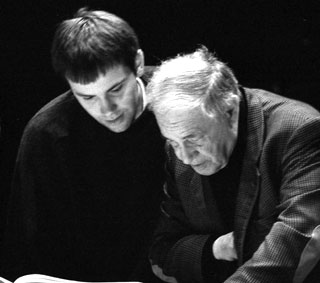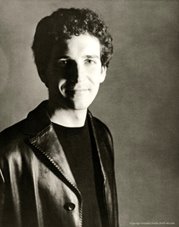French, Finnish, Modern!
 Some classical music lovers run for the hills at the mention of Boulez, Berio, Saariaho, and Dutilleux – others run to the Maison Française’s Contemporary Music Festival instead, to treat themselves to a refreshing dose of 20th- and 21st-century modern and modernist music. There is of course limited use in trying to convince (much less convert) members of the former section of (or to) the latter’s delights, but for those who “do” this kind of music, the French cultural programs under the auspices of Washington’s one-man modern music vanguard, French Cultural Attaché Roland Celette, are an oasis in this musically arch-conservative town.
Some classical music lovers run for the hills at the mention of Boulez, Berio, Saariaho, and Dutilleux – others run to the Maison Française’s Contemporary Music Festival instead, to treat themselves to a refreshing dose of 20th- and 21st-century modern and modernist music. There is of course limited use in trying to convince (much less convert) members of the former section of (or to) the latter’s delights, but for those who “do” this kind of music, the French cultural programs under the auspices of Washington’s one-man modern music vanguard, French Cultural Attaché Roland Celette, are an oasis in this musically arch-conservative town.
Converts would have had a difficult time finding space in the auditorium last Friday, anyway; full of dedicated ears that weathered the snow as it was. In a program of French and Finnish works (for cello, clarinet, and the combination thereof), the distinguished cellist Alexis Descharmes and his equally talented, experienced, and enthusiastic clarinetist partner Nicholas Baldeyrou treated to works of the Argentine Daniel A. d’Adamo, the Franco-Swiss Michaël Jarrell, and Finn Magnus Lindberg in addition to the aforementioned composers. With half the composers under 50 and five out of six alive (Berio’s creative energy was somewhat dampened by his demise in 2003) it was a great and educational example of a particular brand of music with a pulse™.
Katja Saariaho’s Spins and Spells for cello was first to go and sounded like creaking pipes in an old apartment building during winter. Or, as the modern music maven in me would want to exclaim, it explored in fascinating intricacy the resonant and textural properties of the cello (scordatura – custom tuned – no less!) while spreading a holistic sound-cloth, tightly woven of metal strands over the audiences’ audile receptors. Take your pick.
 Playing from six different positions and with his X-ray vision coming in handy in the specially darkened auditorium, Nicholas Baldeyrou’s presentation of Boulez’s Domaines explored overtones and sympathetic vibrations of low, long held notes cut into with shrieks, silence, and ambient sound. I suppose I prefer the version for clarinet and small ensemble, but for the solo version it would have been difficult to get someone better adept at making it work than the Ensemble InterContemporain-schooled Baldeyrou. Mr. d’Amato’s Breath for bass clarinet and cello (the former looks like a saxophone top and bottom glued onto a fat clarinet on growth hormones that sits in the middle) was, comparatively, melodious. Well, not really – but working with both – the instruments’ tone and the sound of their percussive mechanics made for much interesting material. In preparation for another Saariaho piece – Oi Kuu for clarinet and cello – there was a telling and amusing moment when the person setting the stage was temporarily confused whether he planted the score upside down on the music stand or not. Of course critics would leap at the occasion to point out that for the bit of difficulties that had temporarily beset that chap, the audience would have had greater difficulties, still, in noticing the difference at all, had Oi Kuu been played backwards and inverted. At francophile and modernism-embracing Ionarts, of course, we would never be so snarky.
Playing from six different positions and with his X-ray vision coming in handy in the specially darkened auditorium, Nicholas Baldeyrou’s presentation of Boulez’s Domaines explored overtones and sympathetic vibrations of low, long held notes cut into with shrieks, silence, and ambient sound. I suppose I prefer the version for clarinet and small ensemble, but for the solo version it would have been difficult to get someone better adept at making it work than the Ensemble InterContemporain-schooled Baldeyrou. Mr. d’Amato’s Breath for bass clarinet and cello (the former looks like a saxophone top and bottom glued onto a fat clarinet on growth hormones that sits in the middle) was, comparatively, melodious. Well, not really – but working with both – the instruments’ tone and the sound of their percussive mechanics made for much interesting material. In preparation for another Saariaho piece – Oi Kuu for clarinet and cello – there was a telling and amusing moment when the person setting the stage was temporarily confused whether he planted the score upside down on the music stand or not. Of course critics would leap at the occasion to point out that for the bit of difficulties that had temporarily beset that chap, the audience would have had greater difficulties, still, in noticing the difference at all, had Oi Kuu been played backwards and inverted. At francophile and modernism-embracing Ionarts, of course, we would never be so snarky.
 L.Berio, Sequenze Ensemble Intercontemporain DG     |
Henri Dutilleux, the old man of French modernism – a Parisian Elliot Carter of sorts – was represented with Trois strophes sur le nom de Sacher for cello which is based on the 1937 (?) Sache[r] motif (presumably E-flat - A - C - B – E) and honors the man that commissioned a slew of the most important orchestral works of the early and mid-20th century. Not coincidentally, it includes a Bartók quote from one of the works thus paid for with the money Sacher married into. Trois strophes offered more maturity than d’Adamo and Saariaho’s works and less agenda than Boulez. It was easily the most easily enjoyable work of the evening’s bill and in my opinion the only masterpiece. Its characteristic vigorous pizzicato in particular made for much pleasure.
Pitch manipulating and more overtones make Jarell’s Aus Beben educational and interesting in equal measure while offering enough music in between to make listening to the thing worth the curious audience member’s time. Since Magnus Lindberg’s Steamboat Bill, Jr. and Buster Keaton’s film that lend its name to this 1990 work “have similar durational properties” (not to be mistaken for “are the same length”!), it was shown alongside the famous storm scene from that movie. Buster Keaton’s comic genius could make any music listenable. His (literally, in one instance) neck-breaking stunts and jokes are much more timeless than Charlie Chaplin’s, and if the music was not as wild as the storm that drags Keaton on a tree through town, it came pretty close. It ended the concert with wild applause and marked a great success for the very curious ears in this town.





















































